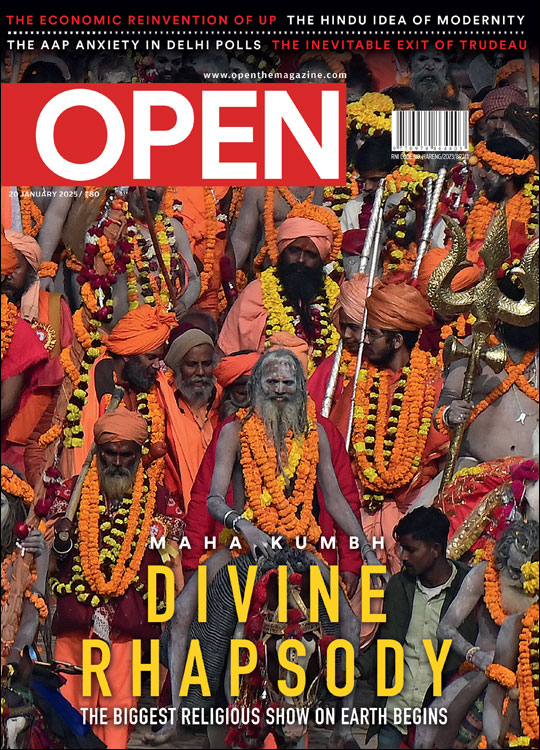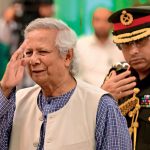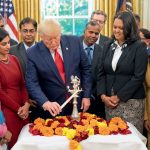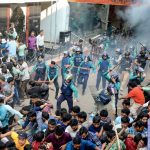Roots and Rights in Assam After the NRC
Identity is destiny
 Ram Madhav
Ram Madhav
 Ram Madhav
Ram Madhav
 |
13 Sep, 2018
|
13 Sep, 2018
/wp-content/uploads/2018/09/Idenitydestiny.jpg)
‘PROBABLY THE MOST important event in the province during the last 25 years—an event, moreover, which seems likely to alter permanently the whole feature of Assam and to destroy the whole structure of Assamese culture and civilization—has been the invasion of a vast horde of land-hungry immigrant.’
This was the warning given by British Census Superintendent CS Mullan as early as 1931 about the influx into Assam.
Toward the Partition of India, this influx acquired humongous proportions. It was no longer just a migration for economic reasons. It acquired political and communal overtones. As it became clear that India would be partitioned on communal lines, interested groups started aggressive campaigns to alter demography, especially in vulnerable areas like Assam.
Syed Saadulla was the Prime Minister of Assam during 1939-46. He was convinced that Assam should become a part of East Pakistan. He aggressively promoted migration of a large number of Muslim peasants and workers from Sylhet and other areas of Bengal into Assam. He deceptively called it ‘Grow More Food campaign’. Lord Wavell, the then Viceroy, aptly described it as ‘Grow More Muslim campaign’. The demography of Assam changed rapidly with large parts in Lower Assam becoming dominated by these migrants.
As a result when the infamous Cabinet Mission Plan was drafted, Assam and Bengal were earmarked as Group C states allowing them to be shared between the new countries taking birth after Partition. Had leaders like Gopinath Bordoloi, the then senior-most Congress leader in Assam, with the overt support of Mahatma Gandhi, not fought back, several areas in Assam, if not the entire state, would have become a part of East Pakistan.
Partition of India was followed by massive influx of populations into both the countries. Looking at the seriousness of its impact on the future of Assam, Prime Minister Nehru called for preparing a list of Indian citizens in the state in 1950. The Immigration (Expulsion from Assam) Act, 1950 was promulgated, which started the initiative called the National Register of Citizens. A list of citizens was prepared with diligence in Assam. Unfortunately, it was never completed.
Waves of infiltration continued. In 1967, when the Prevention of Infiltration from Pakistan (PIP) Act was repealed, a large migration began. It continued through the war years of 1971-72 and thereafter. It became a major threat to Assamese demography.
‘Demography is destiny,’ said French Sociologist Auguste Comte. Assam’s culture, traditions, lands and livelihood came under severe threat due to this unending influx. The infiltrators have occupied fertile lands of Assam. They have not even spared national parks, including Kaziranga National Park. The illegal settlements of the infiltrators had led to major violence in the Bodoland Territorial Area Districts (BTAD) areas when the Bodos violently attacked the infiltrators leading to a large number of deaths. Violence continued four months on. Infiltration has become a major livelihood issue also. All small jobs are being taken away by the infiltrators causing severe economic hardships to the citizens of Assam.
The allegation that the NRC was directed at a particular minority community is baseless. No official data on the basis of religion has been collected during the entire process. The NRC preparation was a transparent and scientific exercise
They even started influencing the state’s political destiny. The 1978 by-elections to Mangaldoi parliamentary constituency, which were announced owing to the demise of the elected MP Hiralal Patowary, became a shocking eye- opener for people of the state and the entire country. When a new voters’ list for the constituency was released, people were aghast to see more than 70,000 new names being added to it. They were largely the infiltrators allegedly brought in by the Congress party in order to capture the seat. It led to widespread protests and finally culminated in the birth of the historic Assam agitation in 1979 against illegal infiltrators led by the newly formed students’ association called the All Assam Students Union (AASU).
The Assam agitation received widespread support from various political and non-political sections of not only Assam but the entire country. After a six-year bloody agitation that saw the martyrdom of over 778 youth of Assam, the famous Assam Accord was signed in 1985 by governments of India and Assam, and the leaders of AASU and Asom Gana Parishad (AGP).
ONE OF THE CENTRAL commitments under the Assam Accord was to prepare a National Register of Citizens (NRC) for Assam. The agitating groups had demanded that the goal of such an exercise should be to detect, delete and deport illegal infiltrators. Preparing the NRC was to be the first step helping detect infiltrators; it was to be followed by disenfranchising them and finally deporting them.
After signing the Assam Accord, both the Centre and the state governments led by the AGP did precious little in the direction of initiating the process for the NRC. It took another three decades for it to finally become a reality.
One of the central commitments under the Assam Accord was to prepare an NRC. The agitating groups had demanded that the goal should be to detect, delete and deport illegal infiltrators
What was unfortunate was that even the Assamese leadership had lacked the courage of conviction to take it forward. A half-hearted effort was made in 2010 when two tehsils in Lower Assam—one each in Barpeta and Kamrup districts— were selected for a pilot project for the NRC. Violent protests by infiltrator mobs in which government offices were targeted led to deaths of several people in police firing and rattled the state government led by Tarun Gogoi. The exercise was immediately shunned and never revived by Chief Minister Gogoi.
The Supreme Court had taken a proactive interest in the matter and ordered for preparation of the citizenship rolls in December 2013. The Court had announced that the process of preparing the NRC would be monitored by it directly. Fortunately, soon after the Supreme Court’s directive, the BJP came to power both at the Centre as well as in the state. Both the governments extended full cooperation, with the Centre pitching in with overall implementation through the Registrar General of India (RGI) while the state on its part provided the required staff—over 30,000 regular and 15,000 contractual employees.
In four years, something that was thought to be impossible became a reality. On 31st July this year, the RGI released the final draft containing the names of 28,983,677 citizens of Assam. As many as 4,070,707 applicants were left out as their citizenship credentials couldn’t be confirmed.
When the draft NRC was released, certain political parties started making wild allegations. It is a travesty that the very same people were once seen shouting from rooftops about illegal infiltration and its consequences. But such is the nature of our politics that the very same people are today siding with infiltrators.
It may be worthwhile to recall that PM Sayeed, as Minister of State for Home Affairs in PV Narasimha Rao’s government, had categorically stated in Parliament in 1995 that lakhs and lakhs of infiltrators are entering into India from across the neighbourhood. In 1997, the then Home Minister and veteran CPI leader Indrajit Gupta had stated that more than one crore infiltrators had entered India and settled down across the country, especially in large numbers in states like Assam, Bengal and Bihar. Even Mamata Banerjee, seen today vociferously defending infiltrators, had rushed into the well of Parliament in 2005, thrown her shawl at the Speaker and accused the then CPM government in West Bengal of turning a blind eye to infiltrators and converting them into their vote bank.
The problem is known to every politician. But vote-bank politics has silenced them. The BJP, having championed the cause from the days of the Assam Agitation, has actively supported the Supreme Court initiative.
No country allows illegal migrants on its soil. The US, with enormous resources at its disposal, is building a fence along its border with Mexico to stop infiltrators
The allegation that the NRC was directed at a particular minority community is baseless. No official data on the basis of religion has been collected during the entire process. The NRC preparation was a transparent and scientific exercise. It was mammoth by any standards in the world. Over 20 completely new digital programmes were written to process 3.29 crore applications. Besides the NRC data of 1951, which was in a dilapidated condition and digitised through a laborious process, voters’ lists before 1971 were also made basic documents for proof of citizenship. Besides, more than a dozen other documents, including school certificates and marriage certificates, were also permitted as proof. Proof of self or parents residing in any part of India before the cut-off date too was sanctioned as documental evidence. More than 6.5 crore such supporting documents had to be verified at the source, which was a gigantic task. Each document was sent to its source and got verified by the issuing agency. More than 2,500 NRC Seva Kendras were set up to help the applicants.
THE VERY FACT that while the citizenship cut-off year for the entire country is the 1951 Census, another two decades were allowed for Assam under the NRC, making March 24th, 1971 as the cut-off date. It demonstrates that migrants, whether legal or illegal, were given two decades of grace time. That itself proves that the exercise is not directed against any community or religious group.
No country allows illegal migrants on its soil. The US, with enormous resources at its disposal, is building a fence along its border with Mexico to stop infiltrators. Even a Muslim country like Saudi Arabia regularly deports thousands of illegal migrants from fellow Muslim countries like Pakistan and Bangladesh. Interestingly, Bangladesh itself is facing a major problem of Rohingya infiltration these days. Over a million Rohingya have illegally crossed into Bangladesh and a majority of them are residing in relief camps supported by many countries including India. Bangladesh’s foreign ministry is in talks with the Myanmar government for the repatriation of Rohingyas. In fact, a team of officials from Bangladesh had recently visited villages in Rakhine province of Myanmar to oversee arrangements for repatriation.
In India, any effort even to identify infiltrators meets with political resistance. Undaunted, the Modi Government is going ahead with the NRC process and also with the process of identifying Rohingya infiltrators from Myanmar in various Indian cities for deportation.
The NRC is yet to cross several bridges. What was released was only a draft register. The Government shall ensure that no genuine citizen is denied his or her rights. Standard operating procedures are in place to ensure that people who migrated from any other part of the country are automatically included in the register. For the remaining, ample time has been given for complaints and corrections. People missed out in the draft NRC can go back with their renewed claims. They will be thoroughly verified and the final NRC will be notified only after that.
Once the final NRC is notified, those who don’t find their names in that shall technically become foreigners. Even then, they will have the option of approaching Foreigners Tribunals functioning in Assam for redressal. There are 100 such tribunals already functioning there, and the Union Home Ministry is contemplating increasing their number manifold based on the final figures. Failing to prove citizenship before the tribunals is also not going to be the end of the road. Such foreigners can approach the high court. Such a long rope is being given only to ensure that no genuine Indian citizen is denied his right to be included in the NRC.
The Government is faced with the challenge of those who come to India as refugees due to persecution or general hardships of the minorities in Pakistan (including Bangladesh), Afghanistan etcetera. This challenge was faced during the first NRC in 1950 itself. Prime Minister Jawaharlal Nehru was categorical that India is duty-bound to accept those refugees. While drafting the Immigration (Expulsion from Assam) Act, 1950, which formed the basis for the NRC, Nehru made sure that the plight of the minorities from the erstwhile East Pakistan was taken into account. The Act had explicitly said that it would NOT apply ‘to any person who on account of civil disturbances or the fear of such disturbances in any area now forming part of Pakistan has been displaced from or left his place of residence in such area and who has subsequently been residing in Assam’. This was how a distinction was sought to be made between economic-political migration and migration of the persecuted minorities. This distinction forms the basis for the proposed Citizenship Amendment Bill 2015 of the Government of India, which applies to the entire country.
The NRC has been a major commitment of the BJP and its ideological parivar for many decades. Finally, the first decisive actions were initiated by the Modi Government to fulfil this commitment. Ensuring security of the country, and securing economic, political and cultural rights of the people of Assam are the main objectives behind this path-breaking exercise.

/wp-content/uploads/2025/01/Cover_Kumbh.jpg)













More Columns
What does the launch of a new political party with radical background mean for Punjab? Rahul Pandita
5 Proven Tips To Manage Pre-Diabetes Naturally Dr. Kriti Soni
Keeping Bangladesh at Bay Siddharth Singh